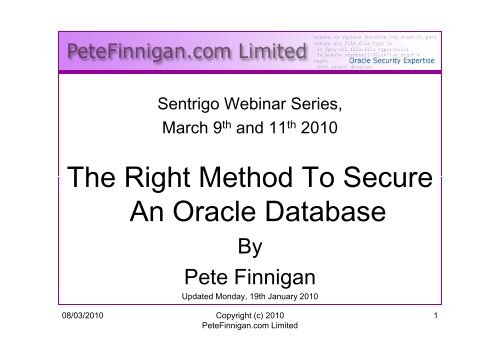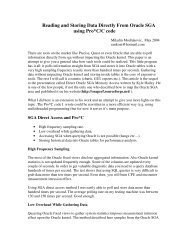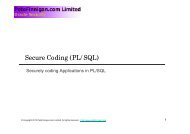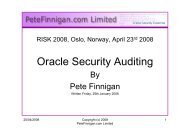The right method to secure an Oracle database - Pete Finnigan
The right method to secure an Oracle database - Pete Finnigan
The right method to secure an Oracle database - Pete Finnigan
Create successful ePaper yourself
Turn your PDF publications into a flip-book with our unique Google optimized e-Paper software.
Sentrigo Webinar Series,<br />
March 9 th <strong>an</strong>d 11 th 2010<br />
<strong>The</strong> Right Method To Secure<br />
An <strong>Oracle</strong> Database<br />
By<br />
<strong>Pete</strong> Finnig<strong>an</strong><br />
Updated Monday, 19th J<strong>an</strong>uary 2010<br />
08/03/2010 Copy<strong>right</strong> (c) 2010<br />
<strong>Pete</strong>Finnig<strong>an</strong>.com Limited<br />
1
Why Am I Qualified To Speak<br />
• <strong>Pete</strong>Finnig<strong>an</strong>.com Ltd, Est 2003.<br />
• http://www.petefinnig<strong>an</strong>.com<br />
• First “<strong>Oracle</strong> security” blog.<br />
• Specialists in researching <strong>an</strong>d<br />
securing <strong>Oracle</strong> <strong>database</strong>s<br />
providing consult<strong>an</strong>cy <strong>an</strong>d training<br />
Database sc<strong>an</strong>ner software authors <strong>an</strong>d vendors.<br />
• Author of <strong>Oracle</strong> security step-by-step book; co-<br />
author of Expert <strong>Oracle</strong> practices.<br />
• Published m<strong>an</strong>y papers, regular speaker (UK,<br />
USA, Slovenia, Norway, Icel<strong>an</strong>d, Finl<strong>an</strong>d <strong>an</strong>d<br />
more).<br />
• Member of the Oak Table Network.<br />
08/03/2010 Copy<strong>right</strong> (c) 2010<br />
<strong>Pete</strong>Finnig<strong>an</strong>.com Limited<br />
2
Quick Quiz!<br />
• How m<strong>an</strong>y people here know “where”<br />
their key data is held?<br />
• How m<strong>an</strong>y people here underst<strong>an</strong>d<br />
exactly “who” c<strong>an</strong> see or “modify”<br />
key data?<br />
• How m<strong>an</strong>y people here underst<strong>an</strong>d<br />
the true “privilege model” employed<br />
<strong>to</strong> protect “key data”?<br />
08/03/2010 Copy<strong>right</strong> (c) 2010<br />
<strong>Pete</strong>Finnig<strong>an</strong>.com Limited<br />
3
Agenda<br />
• Hardening <strong>database</strong>s by checklist<br />
• Problems with checklists<br />
•“<strong>The</strong> <strong>right</strong> <strong>method</strong>”<br />
• Data flow<br />
• Privilege/access assessment<br />
• conclusions<br />
08/03/2010 Copy<strong>right</strong> (c) 2010<br />
<strong>Pete</strong>Finnig<strong>an</strong>.com Limited<br />
4
Why We Need Security<br />
• <strong>The</strong> target is often data not the “DBA” role<br />
• <strong>The</strong> exploits we see on the internet work but<br />
stealing data is much more “real” <strong>an</strong>d easy<br />
• It is easy <strong>to</strong> steal, not rocket science, no skill<br />
• Real theft does not require complex techniques<br />
either<br />
• What do you think happens in real life?<br />
– Exploits c<strong>an</strong> be downloaded for free<br />
– Stealing is easy because systems are open<br />
08/03/2010 Copy<strong>right</strong> (c) 2010<br />
<strong>Pete</strong>Finnig<strong>an</strong>.com Limited<br />
5
Traditional Approach<br />
• Hardening by checklist – good idea?<br />
• A number of them available<br />
– SANS Step-by-step guide<br />
– SANSSCORE<br />
S.C.O.R.E.<br />
– CIS benchmark<br />
– DoD Stig<br />
– IT Govern<strong>an</strong>ce book<br />
– <strong>Oracle</strong>’s own checklist<br />
08/03/2010 Copy<strong>right</strong> (c) 2010<br />
<strong>Pete</strong>Finnig<strong>an</strong>.com Limited<br />
6
Problems With Checklists<br />
• Not m<strong>an</strong>y checklists exist for <strong>Oracle</strong> <strong>database</strong>s<br />
• Most are from same initial source or are very<br />
similar<br />
• Some structure there but not good enough<br />
– “tip based rather th<strong>an</strong> <strong>method</strong> based”<br />
• Lists don’t focus on securing the data<br />
• Difficult <strong>to</strong> implement for a large number of<br />
<strong>database</strong>s<br />
• CIS for inst<strong>an</strong>ce has 158 pages<br />
08/03/2010 Copy<strong>right</strong> (c) 2010<br />
<strong>Pete</strong>Finnig<strong>an</strong>.com Limited<br />
7
• Time solution<br />
Time “vs” Clever<br />
– Could spend m<strong>an</strong> years on even a single<br />
<strong>database</strong><br />
– Finding solutions for each issue is not as<br />
simple as applying what it says in the<br />
document<br />
• Clever solution<br />
– Technical solutions need <strong>to</strong> be specified<br />
– Onion based approach is good<br />
– Basic hardening in parallel<br />
08/03/2010 Copy<strong>right</strong> (c) 2010<br />
<strong>Pete</strong>Finnig<strong>an</strong>.com Limited<br />
8
Examples Of Problems<br />
• Two examples:<br />
1) Check 3.0.2 in CIS states “all files in<br />
$ORACLE_HOME/bin direc<strong>to</strong>ry must have<br />
privileges of 0755 or less – fine - but the<br />
solution states “chmod 0755<br />
$ORACLE_HOME/bin/*” – is it a good idea?<br />
2) Solutions are not as simple as indicated. For<br />
inst<strong>an</strong>ce fixing a weak password should also<br />
include, fix the password, m<strong>an</strong>agement,<br />
hard coded passwords, audit, policy….<br />
08/03/2010 Copy<strong>right</strong> (c) 2010<br />
<strong>Pete</strong>Finnig<strong>an</strong>.com Limited<br />
9
Checklists And PII Data<br />
Search of the CIS<br />
benchmark - <strong>The</strong>re is<br />
some mention of data<br />
BUT it is not focused<br />
08/03/2010 Copy<strong>right</strong> (c) 2010<br />
<strong>Pete</strong>Finnig<strong>an</strong>.com Limited<br />
10
Checklists And Special Data<br />
No special data mentioned<br />
at all in the SANS SCORE<br />
08/03/2010 Copy<strong>right</strong> (c) 2010<br />
<strong>Pete</strong>Finnig<strong>an</strong>.com Limited<br />
11
<strong>The</strong> Right Method To Secure<br />
• Start with “the data”<br />
• Underst<strong>an</strong>d “data flow” <strong>an</strong>d “access”<br />
• Underst<strong>an</strong>d the problem of securing<br />
“your data”<br />
”<br />
• Hardening should be part of the<br />
solution BUT not THE solution<br />
• Checklists do not mention “your” data<br />
08/03/2010 Copy<strong>right</strong> (c) 2010<br />
<strong>Pete</strong>Finnig<strong>an</strong>.com Limited<br />
12
Complex But Simple Solutions Needed<br />
• Overarching solutions are needed<br />
• Remove all types of access from the data<br />
• Ensure only those who should see, c<strong>an</strong> see the<br />
data<br />
• Unfortunately it’s not that simple as there are:<br />
– M<strong>an</strong>y paths <strong>to</strong> the data<br />
– M<strong>an</strong>y copies of data<br />
– Data s<strong>to</strong>red or in tr<strong>an</strong>sit that is accessible<br />
– Data copied outside of the <strong>database</strong><br />
08/03/2010 Copy<strong>right</strong> (c) 2010<br />
<strong>Pete</strong>Finnig<strong>an</strong>.com Limited<br />
13
Underst<strong>an</strong>d Architecture<br />
Users DBA’s Feeds<br />
Other<br />
<strong>database</strong>s<br />
Power<br />
Users<br />
backups<br />
Data<br />
Feeds<br />
Identify each type of person <strong>an</strong>d a sample<br />
account for each<br />
08/03/2010 Copy<strong>right</strong> (c) 2010<br />
<strong>Pete</strong>Finnig<strong>an</strong>.com Limited<br />
14
Data Access Models<br />
ata<br />
, Archive<br />
afiles….<br />
ess <strong>to</strong> Da<br />
xt, Redo,<br />
kups, data<br />
ther Acce<br />
SQL Tex<br />
ack, back<br />
Ot<br />
OS files,<br />
Flashba<br />
Privileges<br />
Privileges<br />
Privileges<br />
Sweeping<br />
Privileges<br />
View<br />
API<br />
View<br />
API<br />
Data Table<br />
Data Table<br />
Data Table<br />
(Copy)<br />
08/03/2010 Copy<strong>right</strong> (c) 2010<br />
<strong>Pete</strong>Finnig<strong>an</strong>.com Limited<br />
15
Data Access Is Not “Flat”<br />
• Data model is not flat – remove the blinkers<br />
• Access <strong>right</strong>s are also not flat<br />
• Data is often replicated<br />
– In other tables – in interfaces – flexfields …<br />
– Indexes<br />
– Shared memory<br />
– Data files<br />
– Operating system<br />
– M<strong>an</strong>y more…<br />
08/03/2010 Copy<strong>right</strong> (c) 2010<br />
<strong>Pete</strong>Finnig<strong>an</strong>.com Limited<br />
16
How / Who<br />
• <strong>The</strong> data must be identified (found?)<br />
• <strong>The</strong> access paths must be found<br />
• <strong>The</strong> “people” – real people identified<br />
• Map <strong>to</strong> these <strong>to</strong> <strong>database</strong> user<br />
accounts<br />
• Assess who c<strong>an</strong> access data <strong>an</strong>d how<br />
• Only now c<strong>an</strong> we hope <strong>to</strong> <strong>secure</strong> data<br />
08/03/2010 Copy<strong>right</strong> (c) 2010<br />
<strong>Pete</strong>Finnig<strong>an</strong>.com Limited<br />
17
Securing Data<br />
• We are going g <strong>to</strong> investigate in depth the issues<br />
around a simple credit card table<br />
• We need <strong>to</strong><br />
– find the credit card details table<br />
– Find duplicate copies of credit card data<br />
– Assess who c<strong>an</strong> access all of the data<br />
– Look for other places the data exists<br />
– More…<br />
• Even these issues are only the “tip of the<br />
iceberg” though!<br />
• Lets dig deeper<br />
08/03/2010 Copy<strong>right</strong> (c) 2010<br />
<strong>Pete</strong>Finnig<strong>an</strong>.com Limited<br />
18
Securing Data - 2<br />
Look for the credit cards<br />
This problem is often<br />
seen. <strong>The</strong> developers<br />
think that everyone<br />
accesses the data via<br />
their application.<br />
<strong>The</strong> encrypted data<br />
could be s<strong>to</strong>len <strong>an</strong>d<br />
cracked off line<br />
08/03/2010 Copy<strong>right</strong> (c) 2010<br />
<strong>Pete</strong>Finnig<strong>an</strong>.com Limited<br />
Or decrypted on-line by<br />
<strong>an</strong>y user<br />
19
Securing Data - 3<br />
Test who c<strong>an</strong> access the credit<br />
card cryp<strong>to</strong> package<br />
Again the same problem applies;<br />
there is a belief that no one will<br />
run this directly!<br />
08/03/2010 Copy<strong>right</strong> (c) 2010<br />
<strong>Pete</strong>Finnig<strong>an</strong>.com Limited<br />
20
Securing Data - 4<br />
Wow, there is not a single<br />
interface <strong>to</strong> our credit card<br />
data.<br />
Each view now needs <strong>to</strong> be<br />
checked <strong>to</strong> see which users<br />
c<strong>an</strong> access the credit card<br />
data via these views<br />
08/03/2010 Copy<strong>right</strong> (c) 2010<br />
<strong>Pete</strong>Finnig<strong>an</strong>.com Limited<br />
21
Securing Data - 5<br />
Follow the same<br />
process as above<br />
Test who c<strong>an</strong> access<br />
the functions found<br />
08/03/2010 Copy<strong>right</strong> (c) 2010<br />
<strong>Pete</strong>Finnig<strong>an</strong>.com Limited<br />
22
Securing Data - 6<br />
<strong>The</strong>re are a number of issues here<br />
<strong>The</strong> data is copied – we c<strong>an</strong> check by<br />
looking at IMPORTER.PAN<br />
<strong>The</strong> data is again duplicated in the<br />
recycle bin – this needs <strong>to</strong> be h<strong>an</strong>dled<br />
Each table found has <strong>to</strong> be checked<br />
for hierarchy <strong>an</strong>d access<br />
If we could not find using simple ideas<br />
as here we would need <strong>to</strong> sample<br />
data or use specific algorithms<br />
08/03/2010 Copy<strong>right</strong> (c) 2010<br />
<strong>Pete</strong>Finnig<strong>an</strong>.com Limited<br />
23
Securing Data - 7<br />
Sweeping privileges are still<br />
d<strong>an</strong>gerous for our data –<br />
o7_dictionary_accessibility<br />
prevents some hacks but<br />
does not s<strong>to</strong>p sweeping<br />
data access<br />
Remember there are other<br />
privileges; INSERT,<br />
UPDATE, DELETE…<br />
Remember other privileges<br />
still that would allow data<br />
theft; TRIGGERS,<br />
EXECUTE PROCEDURE…<br />
08/03/2010 Copy<strong>right</strong> (c) 2010<br />
<strong>Pete</strong>Finnig<strong>an</strong>.com Limited<br />
24
Securing Data - 8<br />
• <strong>The</strong> credit card data c<strong>an</strong> be exposed via export,<br />
list files or <strong>an</strong>y other OS / client based resource<br />
08/03/2010 Copy<strong>right</strong> (c) 2010<br />
<strong>Pete</strong>Finnig<strong>an</strong>.com Limited<br />
25
Securing Data - 9<br />
<strong>The</strong> credit cards c<strong>an</strong> also<br />
be exposed in shared<br />
memory <strong>an</strong>d m<strong>an</strong>y other<br />
places<br />
Privileges that allow<br />
access <strong>to</strong> dynamic data<br />
or meta-data must be<br />
reviewed<br />
08/03/2010 Copy<strong>right</strong> (c) 2010<br />
<strong>Pete</strong>Finnig<strong>an</strong>.com Limited<br />
26
Securing Data - 10<br />
• Securing data is not complex but we must take<br />
care of all access paths <strong>to</strong> the data<br />
• We must consider the hierarchy<br />
• We must consider sweeping privileges<br />
• We must consider data leakage<br />
• We must consider data replication<br />
• <strong>The</strong>re is more…unfortunately…<br />
• In summary securing specific data (“<strong>an</strong>y data”)<br />
is first about knowing where that data is <strong>an</strong>d who<br />
c<strong>an</strong> access it <strong>an</strong>d how it “flows through the<br />
system”<br />
08/03/2010 Copy<strong>right</strong> (c) 2010<br />
<strong>Pete</strong>Finnig<strong>an</strong>.com Limited<br />
27
Users – <strong>The</strong> Opposite Problem<br />
For this example run<br />
INFO: Number of crack attempts = [61791]<br />
INFO: Elapsed time = [4.36 Seconds]<br />
INFO: Cracks per second = [14170]<br />
53 out of 60 accounts cracked in 4.3<br />
seconds<br />
We are not trying <strong>to</strong> break in BUT trying <strong>to</strong><br />
assess the “real security level”<br />
See<br />
http://www.petefinnig<strong>an</strong>.com/oracle_password_cracker.htm<br />
password cracker.htm<br />
This is called the<br />
“Access Issue”<br />
08/03/2010 Copy<strong>right</strong> (c) 2010<br />
<strong>Pete</strong>Finnig<strong>an</strong>.com Limited<br />
28
User Password Analysis<br />
• Shared passwords are a problem<br />
• All privileged accounts have the<br />
same password<br />
• This often implies that the same<br />
people do one job or multiple<br />
people share passwords<br />
• If <strong>database</strong> links exist they<br />
possibly share the same passwords<br />
(check dump files)<br />
• Assess not just “what” you see<br />
BUT also the implications in terms<br />
of m<strong>an</strong>agement <strong>an</strong>d administration<br />
•This is <strong>an</strong> example of just one<br />
issue<br />
08/03/2010 Copy<strong>right</strong> (c) 2010<br />
<strong>Pete</strong>Finnig<strong>an</strong>.com Limited<br />
29
Rounding Up<br />
• A simple picture is built of all access <strong>to</strong> the key<br />
data<br />
• All users are assessed <strong>an</strong>d mapped <strong>to</strong> the data<br />
access<br />
• Solutions are very specific but generally<br />
– Reduce default accounts<br />
– Reduce access <strong>to</strong> data<br />
– Remove duplicate privileges<br />
– Simplify privilege <strong>an</strong>d access models<br />
– Generalise<br />
e 08/03/2010 Copy<strong>right</strong> (c) 2010<br />
<strong>Pete</strong>Finnig<strong>an</strong>.com Limited<br />
30
Conclusions<br />
• <strong>The</strong>re are a few import<strong>an</strong>t lessons we must learn <strong>to</strong> <strong>secure</strong><br />
data held in <strong>an</strong> <strong>Oracle</strong> <strong>database</strong><br />
– We must <strong>secure</strong> the “data” not the software (quite<br />
obviously we MUST <strong>secure</strong> the software <strong>to</strong> achieve “data” t security)<br />
– We must start with the “data” not the software<br />
– We must underst<strong>an</strong>d who/how/why/when “data” could be<br />
s<strong>to</strong>len<br />
• <strong>Oracle</strong> security is complex though because we must consider<br />
“where” the “data” is <strong>an</strong>d “who” c<strong>an</strong> access it <strong>an</strong>d “how”<br />
• Often there are “layers” <strong>an</strong>d “duplication”<br />
• Careful detailed work is often needed<br />
08/03/2010 Copy<strong>right</strong> (c) 2010<br />
<strong>Pete</strong>Finnig<strong>an</strong>.com Limited<br />
31
Any Questions?<br />
08/03/2010 Copy<strong>right</strong> (c) 2010<br />
<strong>Pete</strong>Finnig<strong>an</strong>.com Limited<br />
32
Contact t - <strong>Pete</strong> Finnig<strong>an</strong><br />
i<br />
<strong>Pete</strong>Finnig<strong>an</strong>.com i Limitedit 9 Beech Grove, Acomb<br />
York, YO26 5LD<br />
Phone: +44 (0) 1904 791188<br />
Mobile: +44 (0) 7742 114223<br />
Email: pete@petefinnig<strong>an</strong>.com<br />
08/03/2010 Copy<strong>right</strong> (c) 2010<br />
<strong>Pete</strong>Finnig<strong>an</strong>.com Limited<br />
33






